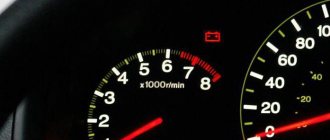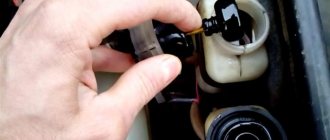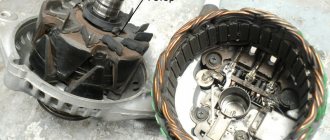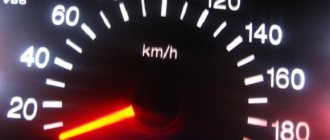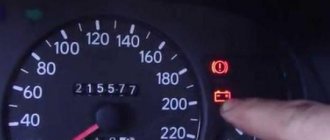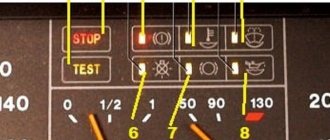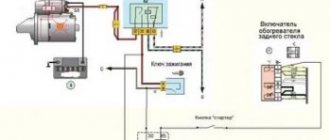Automakers are trying their best to make passenger cars as comfortable to drive and maintain as possible, and saturating them with electronics contributes to this in the best possible way. The on-board computer, receiving information from many sensors, is able to inform the driver about many past or future breakdowns. These indicators also include a battery light, the lighting of which is considered normal only before the engine starts.
In other cases, it can be assumed that the battery does not receive a charge when the power unit is running, and sooner or later this will result in a complete loss of capacity. That is why experts advise not to stop along the way and look for the cause, but to follow to the final destination of the route in order to diagnose the malfunction on the spot.
How does the battery indicator work?
So, we all know that when you turn on the ignition, several warning lights come on at once, including the battery one. The oil pressure lamp goes out after the engine has started running and dispersing lubricating fluid through the system. But the battery light goes out as soon as the engine starts and the generator starts working.
The lighting of the lights is an integral part of the self-diagnosis procedure for important vehicle systems, which starts when the ignition is turned on. If the diagnostics do not reveal any malfunctions, the lights soon go out. So if the battery light comes on briefly when you turn the key, this is normal - at this time the battery supplies current, and when the engine starts running, the generator becomes the current source, which delegates part of its load to the battery, recharging it.
But this is a simplified schematic description of the process; in fact, everything is much more complicated and includes several intermediate elements. Let's describe how everything happens.
When the ignition is turned on, the battery begins to generate current, which goes to the fuse, and then through several circuits - diodes, relay-regulator, then reaches the slip ring and then goes to the winding.
As soon as the internal combustion engine starts working, the voltage at the lamp contacts equalizes, as a result of which the lamp goes out, and the current begins to flow in the opposite direction, from the generator to the battery.
If a problem occurs in any link of this chain, the light does not go out, but continues to burn. Or it lights up unexpectedly and goes out just as suddenly.
Thus, it can be argued that the operation of the battery lamp depends on the functioning of the generator, with one of its contacts connected to the generator terminal directly, and the second connected to the circuit described above coming from the battery.
Main reasons
The main reasons for the lack of indication of the battery charge indicator light when the ignition is turned on (the engine is not running)
The battery charge lamp should be indicated immediately after the vehicle ignition is turned on. This mode is provided to monitor the health of the light bulb (or LED) itself, as well as to control the voltage supply to the generator and instrument panel. If the light does not light up when the ignition is turned on (with the engine not running), the following malfunctions are possible:
- burnout of the incandescent indicator light;
- failure in the instrument panel power circuit;
- blown fuse serving the generator;
- poor fastening, burning or oxidation of battery terminals;
- faulty indicator panel fuse;
- “poor ground” of the engine or connection of the negative terminal of the battery to the body.
- broken contacts of electrical wiring connectors.
Theoretically, it is possible that the battery charging system is operational and the battery will be charged while the engine is running. If you have a multimeter in your car repair kit, you can check the voltage at the battery terminals with the engine running. If it is between 13 and 15 Volts, it means that the battery is charging.
You can drive such a car, but only to the place of proposed repair.
Reasons why the battery charge icon appears while the engine is running
The icon may light up in different ways while the engine is running. Depending on different situations, different reasons are suggested:
- The light comes on when the engine is idling. At the same time, it glows either dimly or brighter. It goes out completely while driving. This situation most likely occurs due to wear on the brushes. They are at a critical level of grinding. It is necessary to immediately replace them or change the voltage regulator assembly. Often such repairs can be performed without dismantling the generator.
This malfunction is also possible when the alternator belt is loose or some liquid gets on it. This may be accompanied by belt whistling. It can be cleaned with a non-aggressive solvent. The belt should also be tensioned using a special tensioner nut or another method. There are engine models in which tension is not provided. In this case, the belt must be replaced.
Sometimes the pulley in the generator is not clamped well; this should also be checked.
- The light came on while starting the first trip of the current day. In many cases, this may be due to poor connections between the battery terminals and the main terminal on the alternator. It is also possible that one of the fuses serving the charging system has blown. The main generator fuse is rated at 80 Amps. It is usually located in the engine compartment.
- Checking the fuse can be done visually, but it is better to use a multimeter, removing it from the connector.
It is also possible that the alternator belt may break. It is necessary to stop the car as quickly as possible, turn off the engine, and check the condition of the belt. Delay is dangerous if a broken belt hits the timing belt, hub, brake system, or CV joint, causing serious damage.
- The battery icon came on suddenly while driving. In some cars, the check light comes on at the same time. In this case, you should also stop the car and turn off the engine. It is necessary to put the car on the handbrake and install the appropriate markings on the highway. Next, you should check the condition of the belt. If it is tight, it is necessary to check the fuses serving the generator, the generator connectors, and the condition of the battery terminals. If you have a multimeter in your car, you should start the engine and check the battery charge. If the voltage at the battery terminals is less than 12 Volts, it is better to immediately go to the place of repair or parking.
List of faults that cause the lamp to light up
So, if you notice that the battery icon on the instrument panel is on and does not go out, you can conclude that it is not charging. There may be several reasons for this:
- the charge is either completely absent or so small that its value is less than the potential difference at the battery terminals;
- the lamp control relay has failed;
- the contacts of the circuit elements are burnt, oxidized or weakened (on the battery itself, on the ground wire, on the generator).
Let's look at these cases in more detail.
Generator
Among the main reasons for the unpleasant fact that the battery icon constantly lights up red on the dashboard of the car may be malfunctions related to the generator:
- the drive belt breaks or is severely weakened - such cases are monitored by the sensor and reported to the on-board computer;
- due to wear of the slip rings or generator brushes. If the wear is not too severe, the light will come on when power consumption increases significantly. Diagnosing such a malfunction requires dismantling and disassembling the generator;
- The battery lamp may also light up if the voltage regulator, which is responsible for maintaining the battery charge level in the required range, fails. As soon as the battery charge voltage drops below the lower threshold, the battery indicator lights up. If too much current flows to the battery, this risks overcharging, boiling of the electrolyte and rapid failure of the expensive element. To check the functionality of the battery lamp monitoring relay, you will need any power source with a voltage regulator. You can, for example, use a laboratory power supply;
- break in the excitation winding circuit. Determined by the tester by “testing” the winding;
- A malfunction of the diode bridge is usually manifested by the blinking of the battery check lamp. Diagnosis is carried out with a multimeter, which must be switched to resistance measurement mode. If it turns out that the diodes are broken, the bridge will need to be replaced.
Diagnostics of charging current value
Usually, to find out why the battery light is on, you should check the battery charging voltage. Here, too, you can’t do without a multimeter, which is set to DC measurement mode (denoted as DCV). In test mode, the engine must operate at idle speed, and the on-board network must be loaded to the maximum, turning on a large number of current consumers. The voltage on the device should not fall below 13.4 V. If you reduce the load on the on-board network to a minimum, the voltage should be in the range of 14.0-14.2 V.
Battery lamp control relay
In many passenger car models, the battery charging circuit has a special relay connected to the battery charging sensor. So, the VAZ classic has a control relay that, when the ignition is turned on, does not interrupt the circuit, as a result of which the battery sign lights up. As soon as the generator starts working, the relay opens and the lamp goes out.
What can a constantly burning battery charging lamp indicate?
If the battery charging light is on in a VAZ 2107 or VAZ 2106, there can be only one reason - the battery is not receiving voltage from the generator, or is receiving it, but its value is insufficient. There may be several malfunctions that lead to this:
- violation of normal contact at the battery terminals;
- loose tension or damage to the alternator belt;
- lack of contact of its “negative” terminal with “ground”;
- break in the rotor excitation circuit or wear of the generator brushes;
- diode bridge malfunction.
- defective fuse;
- failure of the relay regulator.
Troubleshooting
The first thing you need to do if the battery light is on on the instrument panel is to measure the voltage at its terminals. If everything is normal, the voltage measured by the device should remain within the range of 13.5-14.3 V. Problems with recharging will be indicated by values of the order of 12 V.
To fix the problem yourself, we will need the following set of tools:
- two screwdrivers, with a Phillips head and a regular flat head;
- multimeter;
- twelve-volt lamp
- knife;
- pliers;
- medium grit sandpaper.
Repair algorithm
Let's consider the case when the battery light is not on, the standard voltmeter readings are within normal limits, but the voltage at the battery terminals is only 12 V, and the battery itself is almost discharged.
We try to clean the battery terminals and tighten them. If this does not help, measure the voltage on the generator itself (terminal “30”) by connecting the second contact of the multimeter to ground. If the value obtained exceeds that obtained on the battery, it is worth sanding this terminal. Perhaps the reason lies in a broken wire from the generator to the battery.
Case No. 2. The indicator on the dashboard does not light up, the voltage on the battery is normal (about 14 V), but it is dead. If you turn on a powerful load (headlights) with the engine running, and the battery charge arrow is set to zero or close to zero, you can say that the alternator belt is loose. It should be tightened and, if defects are present, replaced. If the belt is not to blame, you should look for the cause in other places: check the stator winding for a break or a breakdown of the diode bridge. We replace the faulty bridge. When the generator brushes are worn, carefully measure their length - the result is less than 5 mm. indicates the need to replace the brushes.
Case No. 3. When you turn the key, the battery indicator does not light up and there is no battery charge. A possible reason is a blown fuse (on different models it has a different rating, most often 10 A). If after replacing the fuse the problem remains, we look for the cause of the malfunction in the lock or ignition relay.
Case No. 4. As a result of turning on the ignition, the battery indicator does not light up, there is no battery charge, but all other devices function properly. The first thing to do is connect the generator wire coming from terminal number 61 to ground. If the lamp lights up, most likely there is a break in the field winding. It is also possible that the contact may loosen. If after cleaning the problem does not disappear, check the lamp itself, it also sometimes burns out.
Case No. 5. After turning on the ignition, the indicator lights up and does not go out after the generator starts operating (it may blink while the engine is running). In such cases, the culprit may be a weak contact on the tidy connector. If this is all right, check the relay-regulator by powering it with 12 volts, for example, from a battery. If the multimeter shows a lower value, the relay is faulty and must be replaced.
Worn brushes or broken generator relay
Regulator relay
A multimeter or voltmeter will help determine the malfunction of the relay and brushes. It is necessary to measure the voltage at the terminals with the engine running and off.
Standards:
- with the engine off – 12.7V;
- with the engine running – 13.6-14.6V.
If the voltage decreases when you turn on the motor instead of increasing, inspect the diode bridge and brushes. Replace if found faulty. The diode bridge can often be independently soldered.
What to do if the battery light on the dashboard
The dashboard displays the most common malfunctions that occur in cars - insufficient engine oil or fuel level, engine overheating, “check”. The designation of all indicators is the same for all car brands - be it a domestic VAZ or an American Ford.
The battery icon may also be illuminated. Most often, this indicates that the battery is not receiving the required level of charge - this is why the battery lights up on the instrument panel . There may be several reasons for this phenomenon, and the car enthusiast should know all the methods for diagnosing and troubleshooting problems.
Possible malfunctions in the generator
If, when diagnosing the battery, the reason why the battery icon is lit on the instrument panel was not found, then you should proceed to the next step - checking the operation of the generator. Before carrying out this activity, you should worry about your safety - wear rubber gloves to avoid electric shock.
Again you will need a multifunctional multimeter, which is used as follows:
- you need to turn off the engine, disconnect the terminals from the battery and measure their voltage - at a normal charge level it should be in the range of 12.4-12.7 Volts;
- connect the terminals, start the engine and measure the voltage again - it should increase to 13.4-14 Volts;
- when the speed increases (pressing the gas pedal), the voltage should increase again, but if it decreases, then the problem 100% lies in the generator.
Main generator failures:
- broken timing belt;
- natural wear of brushes;
- breakdown of the voltage regulator - relay;
- damage to the stator copper winding.
The first two problems can easily be eliminated by replacing the necessary spare parts, but the last two require mandatory replacement of the generator. It is best to consult with a specialist from a service station - he will conduct a full diagnosis and, based on it, recommend the best solution to the difficulties that have arisen.
Other reasons
The battery light on the instrument panel is on
The previous two steps are very rare, but may not bring any results. So why does the battery light on the dashboard come on? First, it’s worth answering the question: are other indicators on? Or maybe the battery icon is not bright, but dim?
In these cases, the reason may lie in the following less serious problems:
- fuse f16 has blown - other indicators should also light up;
- wear of the ignition switch - also absolutely all the icons on the dashboard light up;
- wire break “0”;
- decreased quality of contact between the instrument panel and the battery terminals - this often happens when they are oxidized or heavily soiled.
Troubleshooting
Some breakdowns can be fixed on your own without any special technical knowledge or skills. Other damage requires the involvement of professional auto mechanics. Thus, recommendations for getting rid of all the above defects are as follows:
- sulfation of the plates or their short circuit inevitably leads to the purchase of a new battery;
- recharging the battery will help return it to working condition after a long period of inactivity with the engine turned off, but with electrical appliances turned on (headlights, sound system, etc.);
- Electrolyte leakage or a change in its normal density can only be detected and corrected by a qualified technician;
- You can correct the weakening of the generator belt tension yourself - just press it with your finger, returning it to its normal starting position;
- a timing belt rupture must be urgently replaced;
When driving, you need to constantly monitor the status of the icons on the instrument panel. If some icons light up and then go out again, this is already a good reason to contact the specialists for diagnostic measures. You should not turn a blind eye to the fact that the battery is burning on the dashboard ; untimely measures can cause serious consequences - from large monetary costs to repair the car to a terrible accident.
Battery icon lights up
The battery is on the dashboard, and the tachometer, speedometer and temperature needles immediately drop to zero, but this does not affect the operation of the engine and the entire car.
37, Your gene is 100% intact. +12 volts are supplied to the devices from the battery through the ignition switch - fuse and to power the devices. You lose +12 volts of power to your devices, and where, you need to look for it from the battery to the dashboard. There may be a bad contact in the fuse box or there may be a “cold” solder in it. It could also be in the ignition switch. With the car running, I removed the negative terminal, the car immediately stalled, the green indicator on the battery did not light up. To the service. Yesterday the battery icon came on. After 5-10 minutes I decided to start it - but alas! The battery is dead. We put it on charge. In addition, the ABS icon on the panel periodically lit up, and the power steering malfunctioned - the steering wheel barely turned (when I drove into the box). He disassembled and checked the braid, brushes, anchor - he said that everything was new, not worn out at all (well, since the car was 2007). 9) They charged the battery. I took the car home. It was barely enough to get home. As before: the ABS, steering wheel, and battery icons were on.
Connection diagrams for generators of different models
VAZ 2106 cars are equipped with G-221A generators from the factory. Nowadays, motorists often equip their vehicles with powerful audio systems, navigators and other devices. The G-221A cannot always cope with the increased load. Therefore, now car owners are installing more powerful devices instead. You can install generators such as G-222 or 37.3701 on a VAZ 2106 car.
Connection diagram G-221A
The G-221A generator is installed on VAZ 2101-2104, VAZ-2106, 2107 cars. Its rectified current is 42 A, and its maximum power is 588 W. The connection diagram is shown in the figure below.
Here the numbers indicate:
- Battery.
- Generator.
- Fuse box.
- Ignition switch.
- Dashboard.
The operating principle of this scheme is as follows. When the ignition is turned on, before the car engine spins up the generator, current from the positive terminal of the battery through the ignition switch and the fuse box goes to the warning light. From it, through a diode, it goes to the ground, to which the negative terminal of the VAZ 2107 battery is also connected. Thus, the circuit is closed, the control lamp is on.
When the generator spins up, a positive voltage of +14 V comes from its output to connector 12 of the VAZ 2107 instrument panel, which turns off the diode. The current from the battery stops flowing and the light goes out.
In the video you can see the operating principle of the G-221A generator circuit.
Connection G-222
G-222 is capable of delivering a current of 50 A. Its connection diagram can be found in the figure below.
Its operating principle is as follows. When the key is turned in the ignition switch, voltage from the positive terminal of the battery flows through connector 87 of the ignition relay. After this, through fuse 10 located in the fuse block, it is supplied to terminals 86 and 87 of the indicator relay. The relay closes its contacts, voltage is supplied to the lamp through contacts 7 and 3 of the mounting block, and it lights up.
As the engine spins up and the output voltage increases, the relay contacts open. As a result, the instrument panel indicator lamp goes out.
Connection 37.3701 (G-2108)
Generator 37.3701 was installed on VAZ 2108 cars, but it can be installed on VAZ 2106 and 2107. In terms of dimensions and fasteners, it is similar to the classic G-221. The output current can reach 55 A.
In this circuit, when the ignition is turned on, the +12 V voltage from the battery goes through the closed contacts of the ignition relay, the fuse, which is located in the mounting block and is indicated by number 10 in the diagram. After this, the current through the charging indicator lamp comes through connector 61 of the generator to the excitation winding.
When the rotation speed increases, the voltage on the field winding increases along with it. When the output voltage becomes 12 V, the voltage on both legs of the lamp is equalized and the lamp goes out.
Battery light is on - problem solution
To monitor whether the battery is charged, a special lamp is installed in the dashboard. It lights up if there is no charging. Before you understand why the battery charging light comes on, you need to understand the principle of operation of the generator. And if the battery charging light periodically lights up, this indicates that there is a minor defect in the generator. Let's say that after starting the engine you notice that the battery charging light comes on. With these tools on hand, you can begin repairs if the battery charging light comes on or there is another breakdown in the generator. If the voltmeter on the dashboard shows the presence of charging, but the lamp does not light up, and the battery is discharged, despite the normal voltage in the on-board network, carry out a couple of simple steps. And if the battery charging light comes on due to brush failure, the fault is very easy to find.
The moment we start the engine, in almost every car a pair of indicators on the instrument panel lights up (more about them is written here). We are talking about indicators of oil pressure in the engine, as well as the battery. The answer to the question of why the battery light is on is of interest to many car enthusiasts.
How does the battery charge at startup?
Any car battery interacts with the generator, and after starting the engine it goes into constant charging mode. As engine speed increases, the voltage at the generator output increases. To reduce the current to the optimal level, regardless of the number of revolutions, a special relay regulator is used, which maintains the voltage at the optimal level. If a malfunction occurs in this circuit and the battery does not receive charging from the generator, a warning light on the dashboard lights up.
The battery light is on - the generator brushes are worn out.
Reduce the load on the on-board network, that is, turn off the maximum number of electrical consumers, including the radio, fan, headlights, heated glass, fog lights and wipers. The battery is charged only while the engine is running. If the generator is in order, then ask to check the battery itself; Most likely, the battery light coming on in this case was caused by a faulty battery. Check the terminals on the battery. After this, the battery indicator may go out.
Sometimes the battery light may come on due to wear on the alternator brushes. As a result, no electricity is generated, the battery does not receive the required charge, and the indicator light on the instrument panel lights up. In this case, it is necessary to replace the generator brushes.
Of course, if the fault is in the relay itself, then even with a normal charge the sensor will indicate a fault.
If the battery icon lights up (that is, a red rectangle with plus and minus signs appears on the panel), or the battery icon is blinking, then the problem in the car is most likely with the generator. If there is no belt (it’s broken), we try to turn the generator pulley; if it doesn’t turn, then most likely the generator bearing needs to be replaced. If the belt is standing, check its tension by pressing it with your finger in the middle between the generator pulley and the adjacent pulley.
Some tips for using batteries
If the battery in your car has served all the imaginable and inconceivable periods recommended by the manufacturer, you need to urgently change it. On such a battery, the contact at the terminals is poor, it heats up quickly, and requires replacing the electrolyte very often. There is no point in saving on such an important element for a car as a battery. Remember that even the best batteries can be used for no more than 3–4 years.
When using a battery, do not forget that at sub-zero air temperatures, an overly high discharge can lead to freezing of the electrolyte and damage to the integrity of its case. And with active use of the machine in any conditions (even ideal ones, if such exist), the battery life is significantly reduced.
In addition, work should be carried out periodically to prevent battery sulfation. But it is worth remembering that any battery after 4 years of operation is considered used up and should be replaced.
Finally, we would like to add that it is advisable to fix any detected battery faults immediately. There is no need to put off repairing this equipment until the car simply stops in the middle of the road, or one fine morning you cannot start it.
